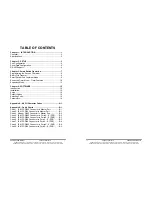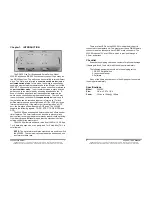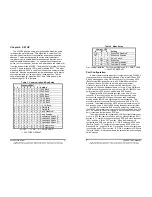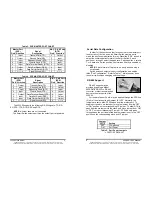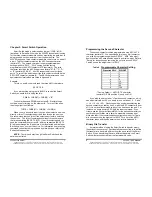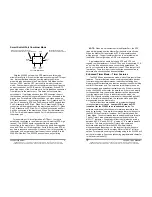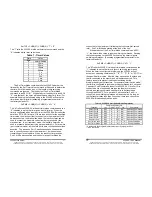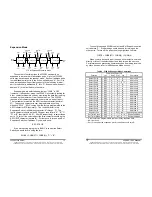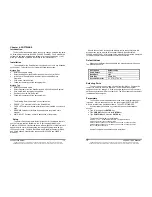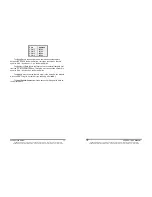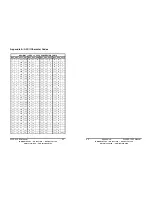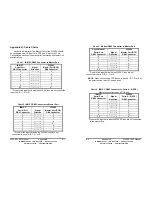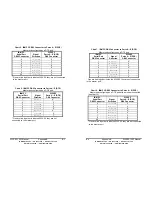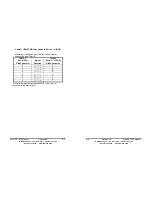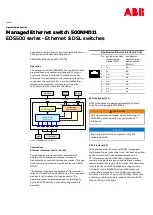
232XS5-1005 Manual
9
B&B Electronics Mfg Co Inc – 707 Dayton Rd - PO Box 1040 - Ottawa IL 61350 - Ph 815-433-5100 - Fax 815-433-5104
B&B Electronics Ltd – Westlink Commercial Park – Oranmore, Galway, Ireland – Ph +353 91-792444 – Fax +353 91-792445
Smart Switch/Port Combiner Mode
With the 232XS5 set up with a DTE master port, this mode
allows Slave Ports A-E to select the master port using the RTS input
line. It also still allows selection from the master port via the
preamble code described in the Smart Switch Only Mode section.
Jumper “JP6-C” must be OFF (removed) to be in port combiner
mode. Port combiner mode is not accessible when the unit is set up
as a port expander, so JP6-B must be ON (installed). When RTS
goes high on any of the five slave ports, it will establish a connection
from that port to the master port. This works on first-come-first-
served basis. If multiple ports have their RTS lines high, the port
that has been waiting the longest will be next to be connected to the
master port. For example (initial conditions -- no slave ports with
RTS lines asserted.), in chronological order, Port C asserts its RTS
line, Port A asserts its RTS line, Port D asserts its RTS line and then
Port C disasserts its RTS line. When Port C asserts its RTS line, a
connection will be made between the master port and Port C. When
Port C disasserts its RTS line, Port C will be disconnected and Port
A will be connected to the master port. When Port A disasserts its
RTS, Port A will be disconnected and Port D will be connected to
the master port.
For example, port A is configured as a DTE port. In order to
establish a connection to the master port, port A must set RTS high
(assert). The 232XS5 would recognize this as a prompt for
connection to the master port. The connection would be dropped as
soon as RTS on port A is brought low. Ports B-E may raise RTS at
any time to request a connection. However, if port A is connected to
the master port, any data sent from the devices on ports B-E to the
232XS5 will be lost. The 232XS5 does not have any buffering.
Master
Port
Preamble code controls access to slave
ports if slave handshake line is not asserted
C
Slave
Port
Port Combiner Mode
Slave
Port
B
Slave
Port
A
Handshake line of any slave
port controls access to master por
Slave
Port
D
E
Slave
Port
232XS5-1005
Manual
B&B Electronics Mfg Co Inc – 707 Dayton Rd - PO Box 1040 - Ottawa IL 61350 - Ph 815-433-5100 - Fax 815-433-5104
B&B Electronics Ltd – Westlink Commercial Park – Oranmore, Galway, Ireland – Ph +353 91-792444 – Fax +353 91-792445
10
NOTE:
When a port is selected via the Master Port, the RTS
lines will be ignored until the Master Port sends the turn off code.
When the Master Port is selected by RTS, all preamble codes
will be ignored. The port combiner function is not available with
the Master Port configured as a DCE or in expansion mode.
A typical application would be to have RTS and CTS tied
together on the master port. When RTS on port A is asserted, CTS
on port A will be asserted when a connection is established. If a
port is not connected to the master port, then CTS on that port will
remain low. Therefore, a port can monitor the handshake line to
determine if a connection has been established.
Enhanced Timer Mode -- Timer Features
The 232XS5 has an enhanced mode, which offers special timer
features. The timer features can be used to prevent slave devices
from receiving preamble commands, inadvertent switching from
binary/graphic file transfers, and inactive slave devices from holding
control of the master port. The timer has two different modes: an
inactivity mode and an inadvertent switch mode. When in inactivity
mode, the 232XS5 will monitor the data lines. If there is no activity
for the specified time, the selected slave port will be disconnected
from the master port. When in inadvertent switch mode, the
232XS5 will ignore switching commands for the specified period of
time. After this time has expired, the selected slave port will be
disconnected from the master port.
The timer functions are enabled via a jumper setting and
through software commands.
Jumper JP6-A must be OFF
(removed) for the 232XS5 to be in enhanced mode.
The
software commands follow the same format as preamble codes
used for switching. There are two commands that must be sent to
the 232XS5 to set the timer functions: Set Timer Value and Set
Timer Mode. These commands require an additional byte for data.
The Set Timer Value command requires the third byte to be an
ASCII “T” character. The data byte (fourth byte) must be a value
between ASCII “0” and ASCII “9”. A value of “0” is used to disable
the timer. The time set by the Set Timer Value command
determines the length of time the 232XS5 wll wait before
disconnecting an inactive port, or the length of time it will ignore
switching commands from the master. Refer to Table 7 for timer
values. For example, sending the following string to the 232XS5 will
set the timer value to 5 seconds (assuming programmable character
is the factory default of 2).


